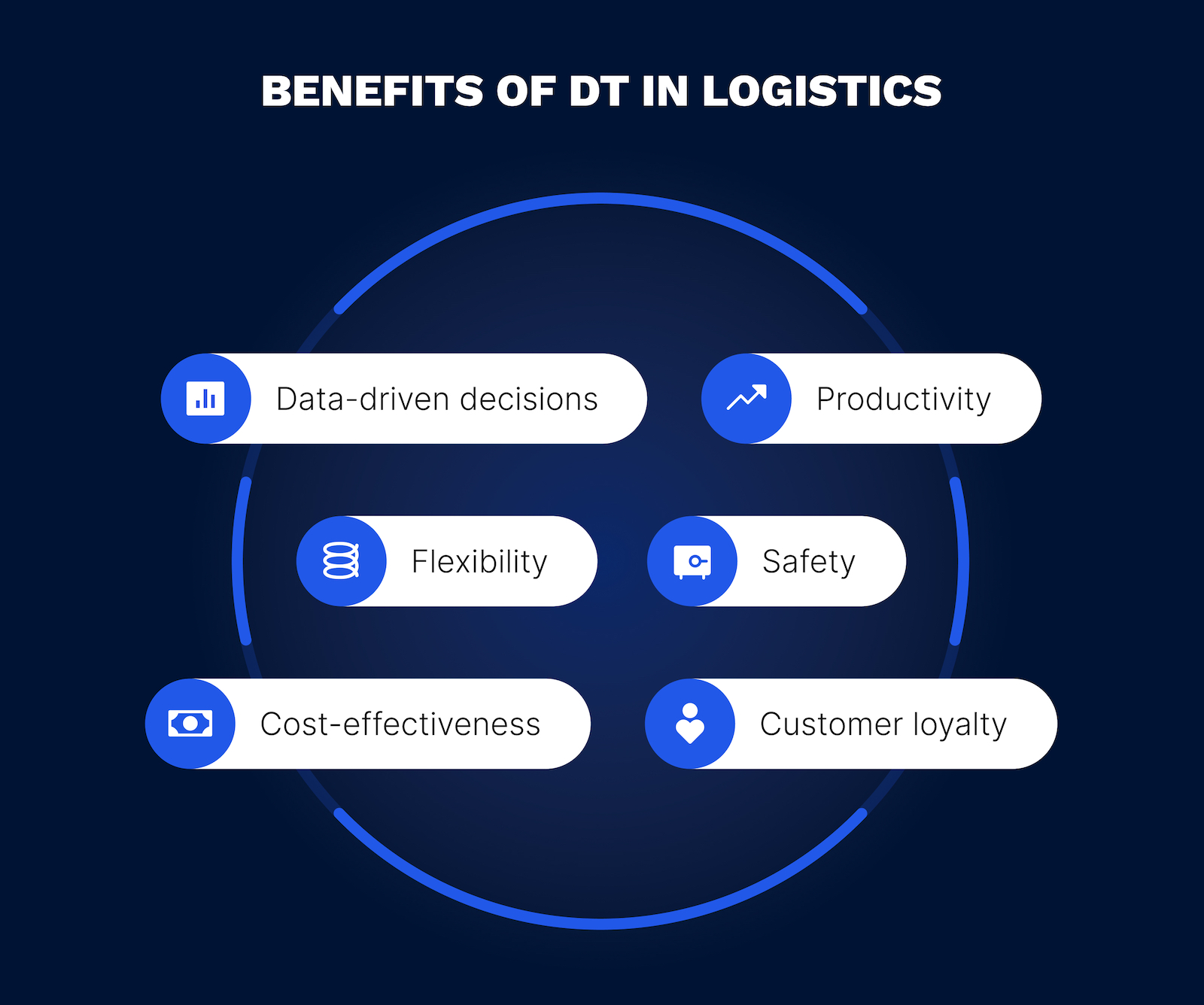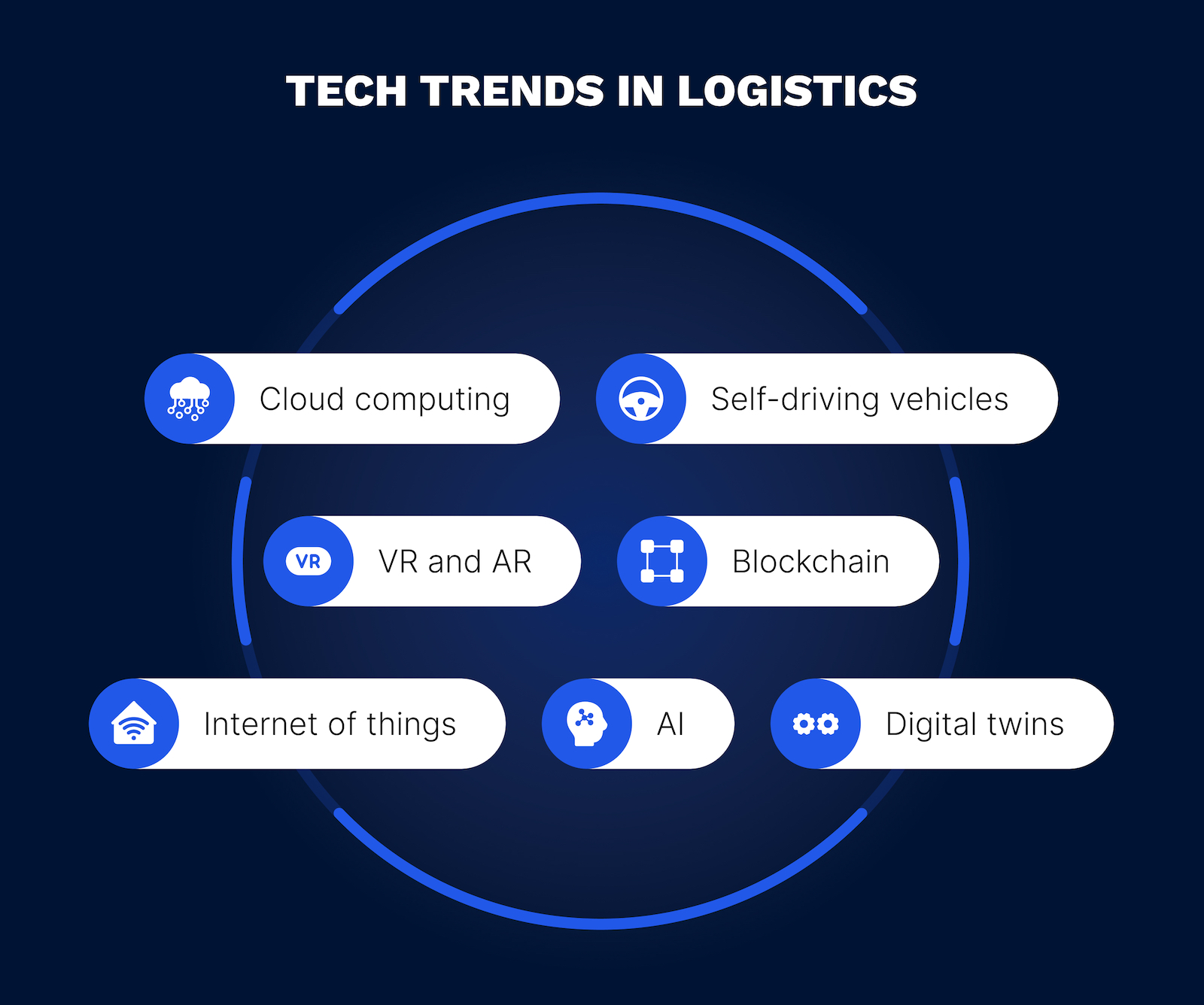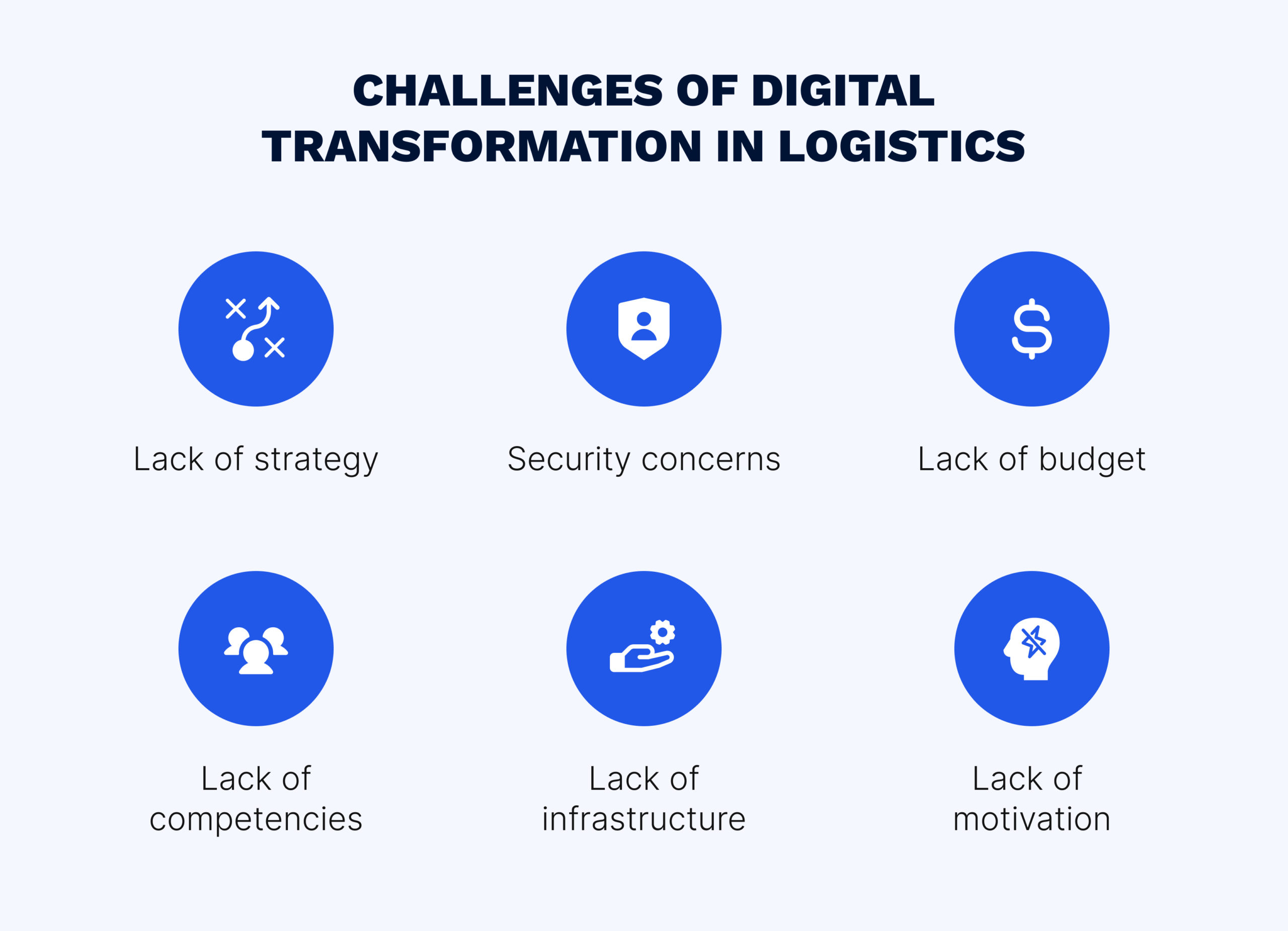
Contact us
Our team would love to hear from you.

The importance of digital transformation in transportation and logistics is hard to overestimate. Efficiency, optimization, and timing have always been vital in every aspect of business operations but particularly in logistics. To achieve them, as well as reduce costs and increase competitiveness, companies must embrace smart technologies.
Read on to explore the digitalization of logistics and transportation, why companies should synchronize their business with technological innovations, what the tech trends to keep an eye on in the 20s, and discover the challenges that may arise on your company’s digital journey.
Digital transformation occurs when a business implements modern technologies in all of its aspects, including its business models and corporate culture, to drive fundamental change. It implies a shift from obsolete systems and processes to those that rely on technological innovations.
A few decades ago, it was hard to conceive of drones and autonomous vehicles delivering goods, onboard telematics optimizing routes, and robots scanning, sorting, and packing items in warehouses. But nowadays, these technologies are part of our reality.
Companies can monitor the position of vehicles in their fleets, no matter where in the world those vehicles are located. In addition, embedded sensors can provide real-time data on the fleets, including fuel levels, wear on spare parts, the status of delivered goods, and more. Delivering fragile or perishable goods is also much easier with state-of-the-art technologies that can create and maintain chosen conditions so that products don’t spoil during delivery.

The world is getting faster and faster and logistics as a driver should be one of the fastest parts of the economy. Understanding this, providers of logistics and transportation services are shifting towards complete digitalization to gain the benefits that the technological innovations can bring. Organizations need to adopt cutting-edge technologies if they want to
With the right tools for automating and streamlining processes at their disposal, employees can work faster and produce great results in less time. This means better outcomes and greater profit for your organization.
If you’re striving to reduce costs, increase revenues, or improve overall efficiency to ensure profitability, you can leverage new technologies to optimize operations introducing automation wherever it’s possible, faster data delivery to employees and customers, boost productivity, and improve the bottom line in the long run.
Customer expectations are growing along with technological advancements that make possible faster service and greater convenience. The technologies provide the possibility to sign orders immediately, provide customers with real time updates on their delivery, make prompt returns and refunds, etc.
Using digital technologies, companies can enforce the security of their data while increasing its visibility and improving employee safety. For example, using wearable devices, supervisors and employees can track the workers’ health, monitor conditions, and manage risk.
Today’s global economic and sociopolitical events are creating an unstable and rapidly changing environment. Implementing cutting-edge technologies allows businesses to be flexible and ready for all kinds of shifts.
Innovative technologies designed to process large amounts of data help companies to gain powerful insights that guide accurate, intelligent, and informed business decisions.
Logistics has come a long way. Most repetitive and routine manual processes are gone. The use of cloud computing, artificial intelligence (AI) and machine learning (ML), big data and analytics, the blockchain, and other advancements have revoltionized the industry. Below, we have highlighted this decade’s most important trends.

Organizations consider cloud computing the most influential technology for digitalization in the logistics industry. Automating a company’s business processes becomes much more affordable with cloud computing because it offers flexibility and real-time access to critical analytics and operational software. Whatever your database cannot process due to size or complexity can be processed with a modern big data platform approach.
The cloud enables the scaling of highly responsive on-demand and pay-per-use business models, which can save companies a lot of money. Such solutions eliminate capital expenditures (server acquisition, technical support, etc.).
Accelerating the turnover of goods, increasing the reliability of deliveries, and improving the level of service are just a few of the benefits that cloud computing offers companies. Combined with the other advanced technologies discussed below, cloud solutions open up a completely new world of logistics and transportation.

IoT infrastructure enables firms to reduce the cost of transporting goods, minimize the risks of unforeseen situations, and facilitate the monitoring of goods in warehouses. Tracking systems that use IoT in the logistics industry reduce the risks of theft and waste, as well as product damage caused by improper storage or adverse weather conditions.
The global IoT market is predicted to continue to expand. According to experts, it will grow robustly with a 13.2% CAGR through the end of this decade. Bu 2030, the total market value of IoT will reach $100,984.5 million. In logistics, IoT will continue to be a buzzword due to the benefits it offers the industry.
With IoT solutions, logistics companies can monitor inventory, secure goods and storage locations, and receive instant notification of any problems or emergencies.
To ensure business efficiency, companies must keep several activities under control simultaneously. That’s what IoT does: assists organizations to achieve this goal.
Gradually, AI is changing from a luxury to a necessity. In logistics and transportation, it is being integrated to both automate routine tasks and make the operational model predictive and proactive, empowering companies to deliver better results.
Artificial intelligence complements human abilities and helps focus employees on the most important business activities. It can accelerate cargo flow, reduce the need for low-skilled personnel, facilitate document processing, predict delivery times, and build a better route by analyzing the external environment.
In logistics, the blockchain in logistics is designed to increase reliability and transparency by helping prevent discrepancies in documentation and increasing the speed of delivery. The technology can be leveraged to create a unified document management system in the cloud, to which all supply chain players have access and can track the location of vehicles, cargo, and products in real time.
Companies are adopting the blockchain as it can bring significant savings to the logistics industry. Smart contracts can automate a large part of document flow and business processes. In addition, the digital ledger can help reduce errors, shorten delivery times, and detect fraud.
With the rise of IoT, big data analytics, cloud computing, artificial intelligence, and virtual reality, once-static digital models become dynamic. Digital twins are full virtual replicas of an object or process. They can predict fluctuations in demand, track the flow of raw materials and goods, and even test scenarios. Thus, organizations can optimize and prepare the supply chain for shocks, increased workloads, and force majeure.
PwC asserts that nearly 47% of the market leaders are using digital twins in their operations. Implementing this technology requires a complex approach that encompasses introducing other state-of-the-art technologies. Although it is difficult and expensive to keep up with the leaders, it is highly likely that in a few years, such sophisticated modeling will be commonplace. Analysts assume that the digital twin industry will continue to grow, reaching a value of $73.5 billion by 2027.
VR and AR are not only about video games. These technologies are now widely used in various industries, including logistics. Market leaders are investing in this domain without considering it a game at all.
Immersive technologies can be useful for staff training and real-time, on-site situation assessment. With 3D data projection, warehouse workers can quickly find the right shelf or container, thus increasing the accuracy and speed of warehouse operations. In addition, the system’s visibility reduces the burden on workers’ concentration and attention. As a result, they are less distracted and have much better control over their environment.
Autonomous machines are closely linked to the near future of logistics. Although full automation remains a long way off, logistics is adopting driverless vehicle technologies much faster than many other industries. Already, they are being used in warehouses to automate the loading, shipping, and packing process and reduce the need for low-skilled labor.
These systems can find the fastest route to avoid traffic congestion and reduce travel costs, ensuring overall security and environmental friendliness. Unlike humans, they can react quickly to sudden road hazards.
Safety, efficiency, and velocity are the most important advantages that autonomous machines offer, which is why more and more logistics companies are investing resources to introduce self-driving vehicles into their businesses.

The journey towards full-scale logistics transformation will be demanding. On the road, companies may face obstacles such as
Privacy and security are critical aspects of digital transformation. It is vital to take measures against possible hacker attacks and ensure data protection and compliance with all the related regulations to avoid the leakage of sensitive data.
Modern infrastructure is considered to be the backbone of innovation since outdated systems can hinder the implementation of advanced technologies. However, companies can upgrade the existing systems and consider a hybrid environment to get value from previous investments.
Digital transformation requires significant investments in technology and talent, which may impede the digitalization of some companies, especially small and medium-sized ones. Before starting the transformation, organizations should analyze their financial capabilities and assess all pitfalls and possible risks on this road, which is much easier and reliable with experts.
Without a clear understanding of what processes should be automated, why it is needed, how to implement it, and where to start, a successful digital transformation is unfeasible.
To drive digital transformation, having skilled professionals with the required expertise is a must. Digital immaturity is often the reason for aversion to change. Reaching out to an experienced team can solve this issue.
Changing the traditional way of working can be uncomfortable and negatively perceived by the staff. To minimize the risk of such reactions, prepare your employees by explaining the necessity of new technologies and demonstrating their benefits.
Despite its limitations, digital transformation is inevitable. To overcome the challenges and realize the full potential of the digital transformation in logistics, the process must be approached holistically and collaboratively.
Experts agree that, in the new market realities, those who have not chosen digital transformation will lose out to their more pragmatic digital competitors. According to McKinsey Digital, The top performing companies have already made bold investments in technology and have strong overall capabilities.
Do you want to keep up with the digital world of tomorrow? We are here to give you a leg up!
Our team would love to hear from you.
Fill out the form, and we’ve got you covered.
What happens next?
San Diego, California
4445 Eastgate Mall, Suite 200
92121, 1-800-288-9659
San Francisco, California
50 California St #1500
94111, 1-800-288-9659
Pittsburgh, Pennsylvania
One Oxford Centre, 500 Grant St Suite 2900
15219, 1-800-288-9659
Durham, North Carolina
RTP Meridian, 2530 Meridian Pkwy Suite 300
27713, 1-800-288-9659
San Jose, Costa Rica
C. 118B, Trejos Montealegre
10203, 1-800-288-9659